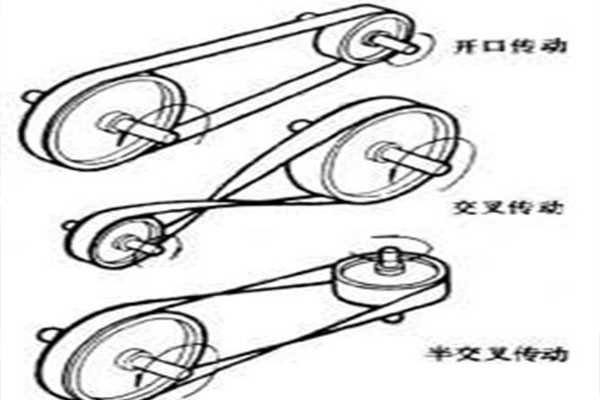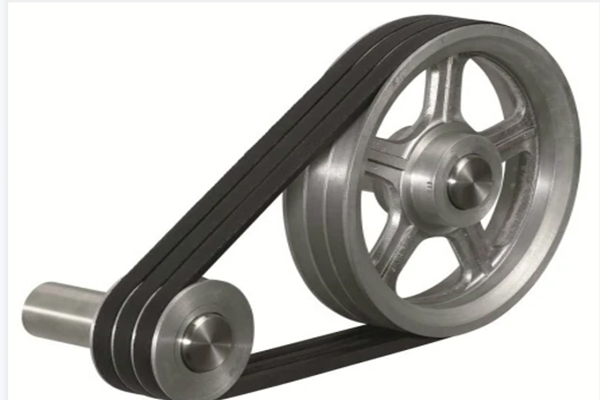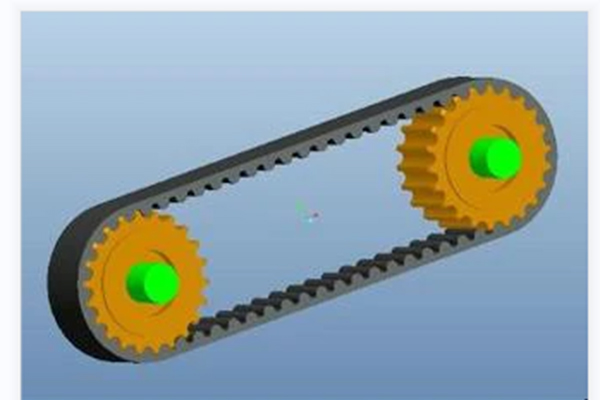Belt drivers are a kind of mechanical transmission that uses a flexible belt tensioned on a pulley for movement or power transmission. According to the different transmission principles, there are friction belt transmissions that rely on the friction between the belt and the pulley, and there are synchronous belt transmissions in which the teeth on the belt and the pulley mesh with each other.
Belt drive has the characteristics of simple structure, stable transmission, buffer, and vibration absorption, can transmit power between large shaft spacing and multiple shafts, and its low cost, no lubrication, easy maintenance, etc., is widely used in modern mechanical transmission. The friction belt drive can overload and slip, and the operating noise is low, but the transmission ratio is not accurate (the sliding rate is less than 2%); The synchronous belt drive can ensure the synchronization of the transmission, but the absorption capacity of load changes is slightly poor, and there is noise in high-speed operation. In addition to transmitting power, belt drives are sometimes used to transport materials and arrange parts.
According to different uses, belt drives can be divided into general industrial drive belts, automotive drive belts, agricultural machinery drive belts and household appliances drive belts. Friction-type transmission belts are divided into flat belts, V-belts, and special belts (Poly-vee roller Belts, round belts) according to their different cross-sectional shapes.
The type of Belt drive is usually selected according to the type, use, use environment, and characteristics of various belts of the working machine. If there are a variety of transmission belts to meet the needs of transmission, the optimal solution can be selected according to the compactness of the transmission structure, production costs, and operating expenses, as well as market supply and other factors. Flat belt drives When the flat belt drive is working, the belt is sleeved on the smooth wheel surface, and the friction between the belt and the wheel surface is used for transmission. The transmission types include open transmission, cross transmission semi-cross transmission, etc., which are respectively adapted to the needs of different relative positions of the driving shaft and the driven shaft and different rotation directions. The flat belt transmission structure is simple, but it is easy to slip, and it is usually used for transmission with a transmission ratio of about 3.
Flat belt drive
Flat type with tape, braided belt, strong nylon belt high-speed annular belt, etc. Adhesive tape is the most used type of flat tape. It has high strength and a wide range of transmitted power. The braided belt is flexible but easy to loosen. A strong nylon belt has high strength and is not easy to relax. Flat belts are available in standard cross-sectional sizes and can be of any length and joined into rings with glued, stitched, or metal joints. The high-speed annular belt is thin and soft, with good flexibility and wear resistance, and can be made into an endless ring, with stable transmission, and is dedicated to high-speed transmission.
V-belt drive
When V-belt drive works, the belt is placed in the corresponding groove on the pulley, and the transmission is realized by the friction between the belt and the two walls of the groove. V-belts are usually used in several ways, and there are a corresponding number of grooves on the pulleys. When the V-belt is used, the belt is in good contact with the wheel, the slippage is small, the transmission ratio is relatively stable, and the operation is stable. V-belt transmission is suitable for occasions with short center distance and large transmission ratio (about 7), and can also work well in vertical and inclined transmission. In addition, because several V-belts are used together, one of them will not be damaged without accidents. Triangle tape is the most used type of triangle tape, which is a non-ending ring tape made of a strong layer, an extension layer, a compression layer, and a wrapping layer. The strong layer is mainly used to withstand the tensile force, the extension layer and the compression layer play the role of extension and compression when bending, and the function of the cloth layer is mainly to enhance the strength of the belt.
V-belts are available in standard cross-sectional sizes and lengths. In addition, there is also a kind of active V-belt, its cross-sectional size standard is the same as the V-B tape, and the length specification is not limited, which is easy to install and tighten and can be partially replaced if it is damaged, but the strength and stability are not as good as the V-B tape. V-belts are often used in parallel, and the model, number, and structure size of the belt can be determined according to the power transmitted and the speed of the small wheel.
1) Standard V-belts are used for household facilities, agricultural machinery, and heavy machinery. The ratio of top width to height is 1.6:1. A belt structure that uses cord and fiber bundles as tension elements transmits much less power than a narrow V-belt of equal width. Due to their high tensile strength and lateral stiffness, these belts are suitable for harsh working conditions with sudden changes in load. The belt speed is allowed to reach 30m/s and the bending frequency can reach 40Hz.
2) Narrow V-belts were used in the construction of cars and machines in the 60s and 70s of the 20th century. The ratio of top width to height is 1.2:1. The Narrow V-Band is an improved variant of the standard V-Band that eliminates the central part that does not contribute much to power transfer. It transmits more power than a standard V-belt of the same width. A toothed belt variant that rarely slips when used on small pulleys. Belt speeds of up to 42 m/s and bending
frequencies of up to 100 Hz are possible.
3) Rough Edge V-Belt Thick Edge Narrow V-Belt for Automobiles, Press DIN7753 Part 3, the fibers under the surface are perpendicular to the direction of movement of the belt, making the belt highly flexible, as well as excellent lateral stiffness and high wear resistance. These fibers also provide good support for specially treated tensile elements. Especially when used on small-diameter pulleys, this structure can improve the belt transmission capacity and have a longer service life than the narrow V-belt with the edging.
4) Further development latest development of the V-belt is the fiber-bearing element made of Kevlar. Kevlar has high tensile strength, low elongation, and can withstand high temperatures.
Belt DriveTiming Belt
Timing Belt
This is a special belt drive. The working surface of the belt is made into a tooth shape, and the rim surface of the belt pulley is also made into a corresponding tooth shape, and the belt and the pulley are mainly driven by meshing. Synchronous toothed belts are generally made of thin steel wire rope as a strong layer, and the outer bread is covered with polychloride or neoprene. The center line of the strong layer is determined to be the section line of the belt, and the circumference of the belt line is the nominal length. The basic parameters of the band are the circumferential section p and the modulus m. The circumferential node p is equal to the size measured along the joint line between the corresponding points of the adjacent two teeth, and the modulus m=p/π. China's synchronous toothed belts adopt a modulus system, and their specifications are expressed by modulus×bandwidth× number of teeth. Compared with ordinary belt transmission, the characteristics of synchronous toothed belt transmission are: the deformation of the strong layer made of wire rope is very small after loading, the circumference of the toothed belt is basically unchanged, there is no relative sliding between the belt and the pulley, and the transmission ratio is constant and accurate; The toothed belt is thin and light, which can be used in occasions with high speed, the linear speed can reach 40 m/s, the transmission ratio can reach 10, and the transmission efficiency can reach 98%; Compact structure and good wear resistance; Due to the small pretension, the bearing capacity is also small; The manufacturing and installation accuracy requirements are very high, and the center distance is strict, so the cost is high. Synchronous toothed belt drives are mainly used in applications that require accurate transmission ratios, such as peripheral equipment in computers, movie projectors, video recorders, and textile machinery.
Product Video
Quickly find products
About Global
GLOBAL CONVEYOR SUPPLIES COMPANY LIMITED (GCS), Owns the GCS and RKM brands, and specializes in manufacturing belt drive roller,chain drive rollers,non-powered rollers,turning rollers,belt conveyor, and roller conveyors.
GCS adopts advanced technology in manufacturing operations and has obtained an ISO9001:2015 Quality Management System Certificate. Our company occupies a land area of 20,000 square meters, including a production area of 10,000 square meters, and is a market leader in the production of conveying devices and accessories.
Have comments regarding this post or topics that you would like to see us cover in the future?
Send us an email at :gcs@gcsconveyor.com
Post time: Nov-30-2023




